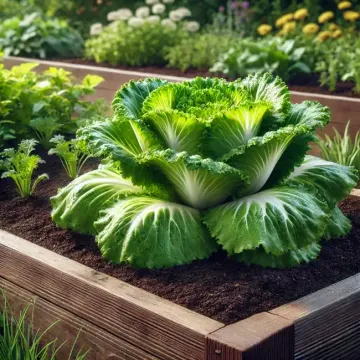Endive, a leafy green vegetable with a slightly bitter flavor, belongs to the chicory family and is often used in salads, soups, and sautés. Known for its crisp texture and distinct taste, endive is a versatile addition to the home garden. There are two main types of endive: curly endive (also called frisée) and broad-leaved endive (escarole). Both varieties are easy to grow and thrive in cool weather, making them ideal for spring and fall gardening.
History of Endive
Endive has a long history in Europe, especially in Mediterranean regions. It is believed to have originated in ancient Egypt, where it was cultivated for its medicinal properties. Over time, it spread to Greece and Rome, becoming a popular vegetable in European kitchens. Today, it is still a staple in many Mediterranean dishes, known for its digestive benefits and high nutritional value.
Health Benefits of Endive
Endive is low in calories but high in essential nutrients, making it a health-conscious choice for home gardeners. It is rich in fiber, which aids in digestion and helps regulate blood sugar levels. Additionally, endive contains vitamins A, C, and K, which support healthy skin, immune function, and bone health. Its high antioxidant content may help reduce inflammation and protect against chronic diseases.
Culinary Uses of Endive
Endive's crisp texture and slightly bitter flavor make it a perfect ingredient for salads, adding a refreshing contrast to sweeter greens. It pairs well with citrus fruits, nuts, and cheeses, creating a well-balanced and flavorful dish. In cooked dishes, endive can be sautéed, grilled, or baked. Escarole, in particular, is often used in soups and stews, adding both texture and flavor. Endive can also be used as a healthy, low-carb alternative to crackers or bread for serving dips and spreads.
Growing Tips for Endive
1. Planting:
Endive is a cool-season crop, so it’s best planted in early spring or late summer for a fall harvest. It thrives in well-drained soil with a pH between 6.0 and 7.0. To get started, sow seeds directly in the garden about ¼ inch deep and space them 6-12 inches apart. For a head start on the growing season, you can also start seeds indoors 4-6 weeks before the last frost and transplant the seedlings outdoors once the soil has warmed.
2. Sunlight:
Endive requires full sun, at least 6 hours of sunlight daily, to grow well. However, in hotter climates, it may benefit from some afternoon shade to prevent the leaves from becoming too bitter.
3. Watering:
Keep the soil consistently moist, but not waterlogged. Endive plants need regular watering to maintain tender leaves, so aim to water deeply once or twice a week, depending on weather conditions. Mulching around the plants can help retain soil moisture and reduce weed growth.
4. Fertilizing:
Endive is a relatively light feeder, but it benefits from a balanced fertilizer applied at planting and once during the growing season. A 10-10-10 fertilizer or compost can provide the necessary nutrients to support healthy growth.
5. Thinning and Harvesting:
As the plants grow, thin them to allow adequate space for air circulation, which helps prevent disease. Depending on the variety, endive is ready to harvest 80-90 days after planting. For curly endive, you can begin harvesting the outer leaves as needed, while escarole can be harvested as a whole head once it reaches a desirable size. To reduce the bitterness, some gardeners blanch the plants by tying the outer leaves together or covering them to block sunlight for a week or two before harvest.
6. Pests and Diseases:
Endive is relatively resistant to pests and diseases, but it can occasionally attract aphids, slugs, and snails. To protect your plants, use insecticidal soap for aphids and organic slug bait for slugs and snails. Endive is also susceptible to downy mildew and leaf spot, so avoid overhead watering and ensure good air circulation between plants.
7. Companion Planting:
Endive pairs well with companion plants like carrots, radishes, and beans. These plants can help improve soil health and deter pests. Avoid planting endive near plants from the same family, such as lettuce, to reduce the risk of shared diseases.
Conclusion
Growing endive in your home garden is a rewarding experience that yields a nutritious and versatile vegetable. With its rich history, health benefits, and culinary uses, endive adds value to any garden. By following these growing tips, you can enjoy fresh, homegrown endive in your salads, soups, and more throughout the cool seasons. Whether you prefer the curly variety or the broad-leaved type, endive is an excellent choice for both beginner and experienced gardeners.

